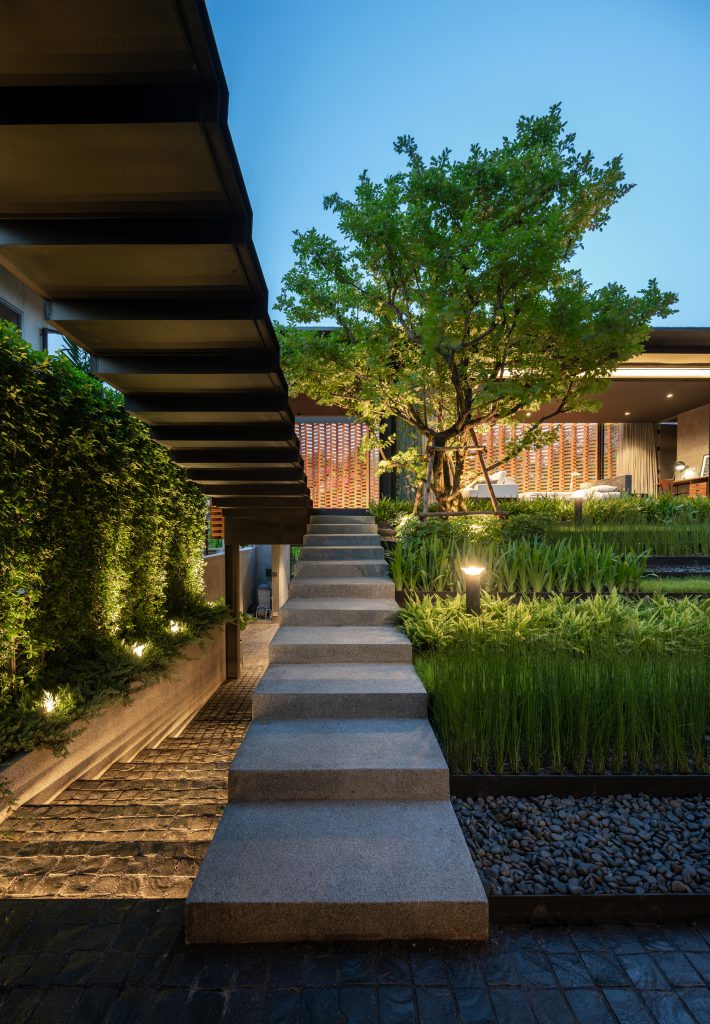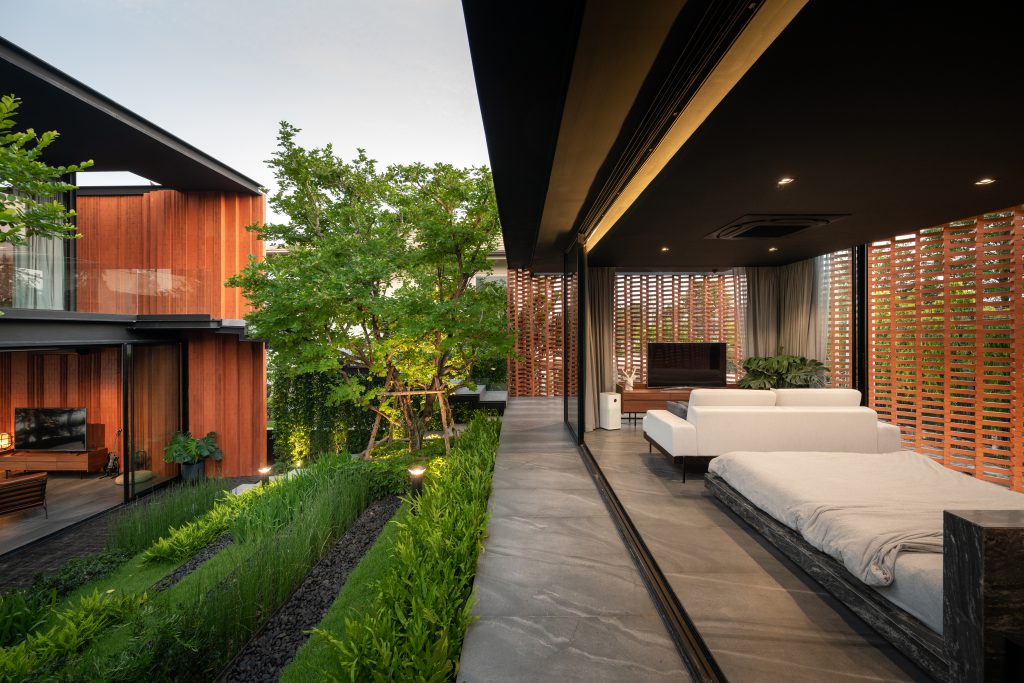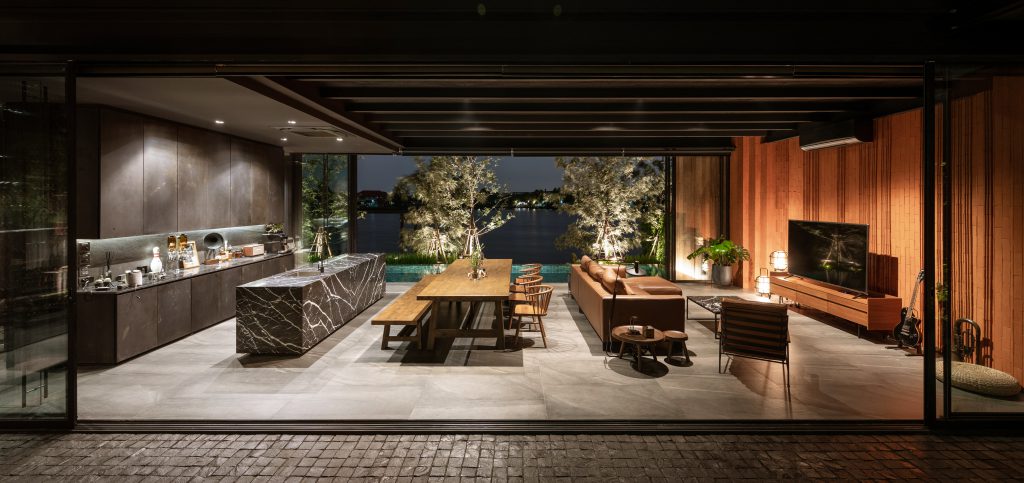Privacy, openness, and seeing through – a house designed by WARchitect shows that a good work of design can find a way for the two elements to coexist beautifully.
Text: Nathanich Chaidee
Photo: Rungkit Charoenwat, WARchitect except as noted
Download the online journal Issue 03 Seeing Through Click here
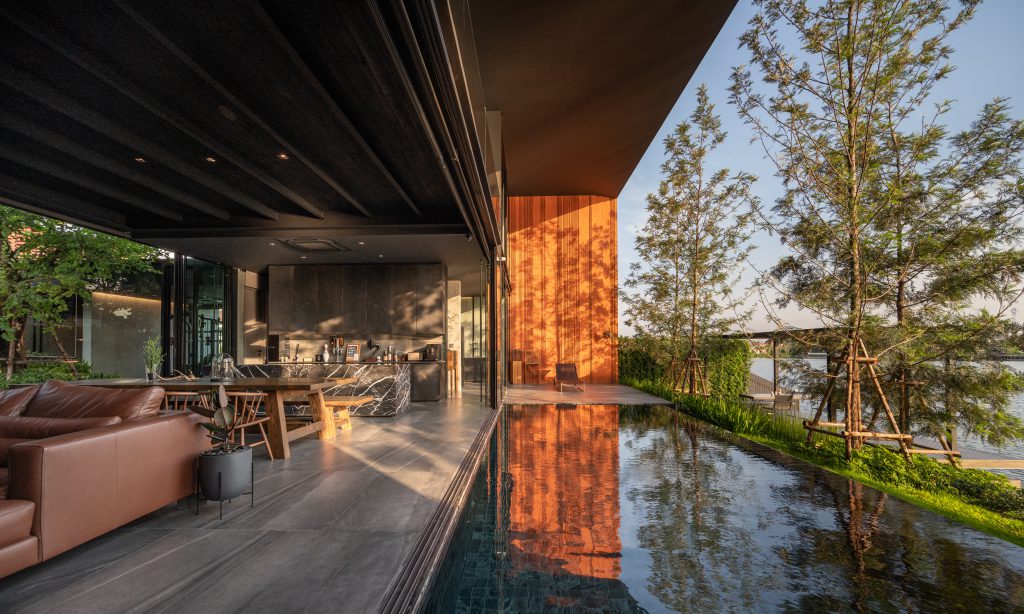
หลายคนคงเคยเห็นบ้านหลังนี้ผ่านตาจากหลายสื่อ เพราะนอกจากเป็นบ้านของนักแต่งเพลงชื่อดังอย่างณรงค์วิทย์ เตชะธนะวัฒน์ แล้ว ยังเป็นบ้านที่สร้างเซอร์ไพรส์ให้ผู้คนจากมุมมองที่เปิดกว้างออกสู่วิวทะเลสาบ ในมุมมองทางสถาปัตยกรรม บ้านหลังนี้มีเรื่องราวที่น่าสนใจที่เล่นกับการปิด การเปิด และประสาทสัมผัสระหว่างการใช้งานพื้นที่ที่น่าสนใจมากทีเดียว WARchitect โดยธาวิน หาญบุญเศรษฐ เป็นสถาปนิกผู้ออกแบบงานสถาปัตยกรรมชิ้นนี้ แม้โปรแกรมจะเป็นเพียงบ้านของหนุ่มโสดที่ไม่ซับซ้อนมากนัก แต่โจทย์และความสนุกของการทำงานครั้งนี้คือบริบทที่อยู่รายล้อม และการดึงศักยภาพของสถาปัตยกรรมมาสร้างความรู้สึกผ่านประสาทสัมผัสของผู้ใช้งานทั้งผู้อยู่อาศัยและแขกผู้มาเยือนให้ได้มากที่สุด
ความเป็นส่วนตัว และความต้องการมุมมองที่เปิดออกสู่วิวทะเลสาบที่อยู่เคียงข้างผืนที่ดิน เป็นเนื้อหาสำคัญที่จำเป็นต้องสื่อสารผ่านการอยู่อาศัยในอาคารหลังนี้ให้ได้ ด้วยบริบทของที่ตั้งที่ด้านหนึ่งติดทะเลสาบ ฝั่งตรงข้ามที่เป็นหน้าบ้านเชื่อมต่อกับถนนสาธารณะที่ผู้คนค่อนข้างพลุกพล่านในเวลากลางวัน ส่วนอีกสองด้านของบ้านเป็นเพื่อนบ้าน การเปิดหมดและปิดหมดจึงเป็นตัวเลือกของการจัดการผนังอาคาร ฟาซาดสำหรับห่อหุ้มอาคาร ไปพร้อมกับการจัดผังอาคารตามโปรแกรมเรื่องความถี่ของการใช้งาน เพราะยึดวิวของทะเลสาบเป็นทัศนียภาพหลัก ตัวอาคารสองหลังจึงใช้การไล่ระดับจากสวนริมน้ำ ยกอาคารขึ้นมา 1.2 เมตรเป็นห้องนั่งเล่นที่ติดกับริมน้ำ มาถึงคอร์ทยาร์ดตรงกลาง แล้วค่อยส่งต่อสู่อาคารหน้าบ้านที่เป็นห้องนอนชั้นบนตามแนวเนินดินที่สูงขึ้น 1.8 เมตร เป็นทางเดินเข้าไปสู่ส่วนห้องนอนชั้นสอง และคลุมที่จอดรถชั้นล่างไปในตัว รูปด้านของอาคารที่หันหน้าเข้าทะเลสาบจึงเปิดกรอบบานหน้าต่างบานเลื่อนแบบเต็มผืนเพื่อเปิดมุมมองสู่ทิวทัศน์ภายนอกให้ได้มากที่สุดโดยไม่มีส่วนใดบดบังกันเลย

การจัดการความเป็นส่วนตัวของบ้านเริ่มตั้งแต่ทางเข้าบ้านที่เลือกจัดการทางสัญจรด้วยแนวคิดแบบทางเข้ารีสอร์ทหรือพิพิธภัณฑ์ที่สร้างเซอร์ไพรส์ตลอดเส้นทางที่เดิน “เราไม่ค่อยออกแบบทางสัญจรแบบนี้ในบ้านเท่าไหร่นัก เพราะคิดกันว่าบ้านเป็นพื้นที่ใช้งานทุกวัน เห็นทุกวันก็ชิน แต่การได้รีเซ็ทตัวเองผ่านการเดินเข้าบ้าน หรือความสุขจากที่ได้เห็นแขกผู้มาเยือนตื่นเต้นจากทางเข้าบ้านที่เหมือนรีสอร์ทแบบนี้ ก็เป็นความสุขของเจ้าของบ้านเหมือนกัน” ธาวินเล่า
จากอาคารส่วนด้านหน้าบ้านที่ติดกับถนน ฟาซาดอิฐเรียงทแยงก่อไขว้แบบเว้นร่อง ด้วยการเลือกอิฐที่ขนาด 5 x 5 x 30 เซนติเมตร ช่องว่างที่เกิดขึ้นระหว่างตัวอิฐได้สัดส่วน 4:6 ซึ่งตอบทั้งเรื่องความงาม และการปกปิดเพื่อความเป็นส่วนตัวได้อย่างดี ส่วนเหตุผลที่ส่วนหน้าสุดเลือกใช้อิฐ นั่นก็เพราะอิฐเป็นวัสดุพร้อมเก่า ด้วยสัจจะของการใช้งานที่เก่าแล้วก็ยังสวย จึงเลือกอิฐเป็นวัสดุฟาซาดด้านหน้า ถัดมาเป็นส่วนของคอร์ทยาร์ดตรงกลางบ้านที่ใช้ร่มไม้ใหญ่ของต้นมะเม่าสองต้นช่วยพรางสายตาและพรางความร้อนก่อนเข้าสู่ส่วนห้องนอน ด้วยรูปฟอร์มที่เหมือนกับเป็นม่านกรองธรรมชาติชั้นหนึ่ง กิ่งสีเข้ม ใบสีอ่อน จึงเหมือนกับเป็นสวนป่าที่ช่วยกรองความเป็นส่วนตัวให้กับพื้นที่ส่วนตัว โดยมีทางเดินเชื่อมจากอาคารห้องนั่งเล่นเข้าสู่อาคารห้องนอน ซึ่งทางเดินเชื่อมนี้เป็นแบบเปิดโล่ง ไม่มีหลังคา เหตุผลหนึ่งก็เพื่อขับให้สถาปัตยกรรมโดดเด่นขึ้น และอีกส่วนหนึ่งเป็นเหตุผลทางเรื่องสุนทรียะระหว่างการใช้งานที่เข้าถึงธรรมชาติแบบตรงตัว
“สถาปัตยกรรมที่ดีจะมีความเหนือจริงแบบนี้อยู่เสมอ เพียงแต่คนอาจจะไม่ได้ไปสังเกตมาก”
ธาวินเล่าถึงการเปิดพื้นที่ส่วนนี้ที่ต่างจากบ้านหลังอื่นโดยสิ้นเชิง เพราะเจ้าของบ้านเป็นคนเข้าใจและรับได้กับการใช้พื้นที่ท่ามกลางธรรมชาติที่ผันแปรตลอดทั้งวัน หากในวันฝนตกจะต้องกางร่ม พื้นเปียกน้ำ เดินจากอาคารนั่งเล่นไปยังอาคารห้องนอน เขาก็มองว่าเป็นเรื่องของธรรมชาติ หัวใจหลักของบ้านหลังนี้คืออาคารนั่งเล่นที่เจ้าของใช้งานมากที่สุด ทั้งกับการนั่งทำงานแต่งเพลง และพักผ่อนหย่อนใจตลอดวัน ผนังด้านกว้างของอาคารจึงเปิดอย่างเต็มที่ออกสู่คอร์ทยาร์ดและวิวทะเลสาบผ่านผืนผนังกระจกเต็มบาน โดยเฉพาะกับด้านทะเลสาบที่เป็นทิศตะวันตกซึ่งรับแสงแดดพอดี สถาปนิกเลือกใช้การยื่นชายคายาว 3.5 เมตร ร่วมในการบังแดดช่วงกลางวัน พร้อมกับการติดฟิล์มกรองแสงที่กระจก และใช้ม่านม้วนทึบเป็นตัวช่วยในวันแดดแรง

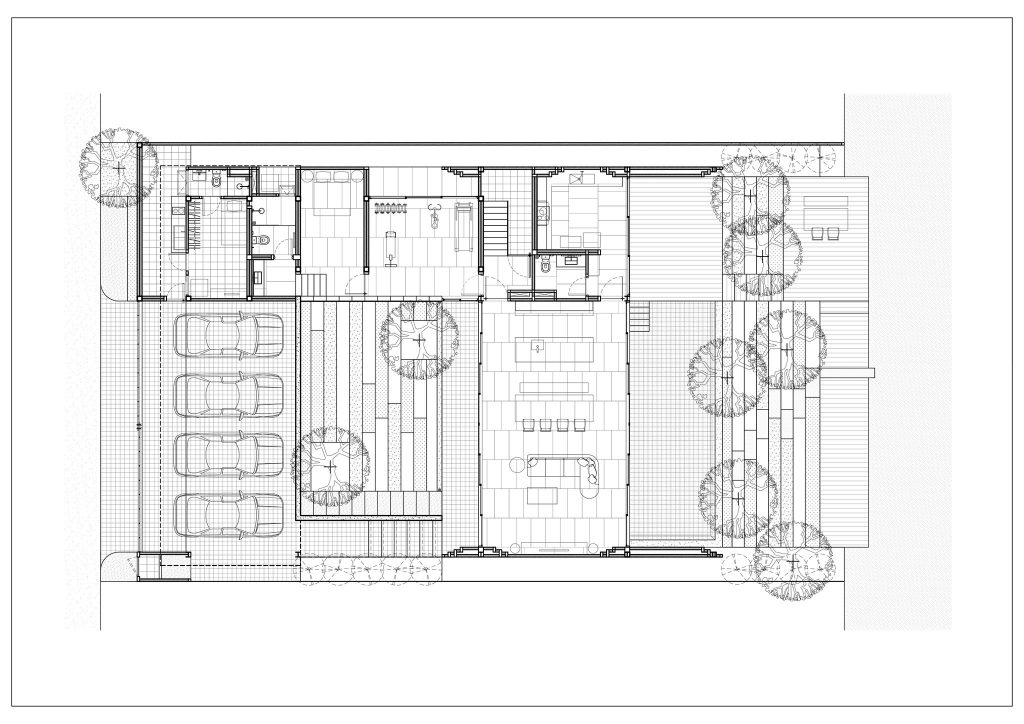
ในส่วนงานออกแบบภายในและวัสดุ สถาปนิกศึกษาจากความชอบจากบ้านหลังก่อนหน้าของเจ้าของบ้าน ร่วมกับการพูดคุยเพื่อค้นหาวัสดุที่ตอบรสนิยมของผู้อยู่ให้ได้มากที่สุด จนได้คำตอบออกมาเป็นลอฟท์สะอาด วัสดุที่แปลกตาสำหรับการใช้งานอย่างพื้นผิวกรวดล้าง อิฐ หรือเหล็กขึ้นสนิมจึงถูกเลือกมาเป็นวัสดุเท็กซ์เจอร์ที่ช่วยเติมอารมณ์และความเป็นบ้านให้มากขึ้นอีก เราถามธาวินถึงความท้าทายในการทำงานสถาปัตยกรรมครั้งนี้ “งานนี้พอโจทย์มันดีมาก เจ้าของรู้จักตัวเอง ไลฟ์สไตล์ ความชอบ และเปิดกว้างกับงานออกแบบ เลยทำให้เรารู้สึกว่าความเป็นไปได้มันเยอะ ความจำกัดมันไม่ได้เป็นความยาก เพราะความยากคือความที่ไม่มีจำกัด ยิ่งไม่มีจำกัดก็ยิ่งท้าทายเรา”
หากมองผิวเผินแล้ว บ้านหลังนี้เหมือนกับจะเปิดออกผ่านผนังกระจกให้เห็นการใช้ชีวิตภายในทั้งหมด แต่ด้วยงานดีไซน์ การเลือกใช้วัสดุ และองค์ประกอบทางสถาปัตยกรรมอย่างมีที่มา ทั้งหมดส่งเสริมให้สถาปัตยกรรมตอบโจทย์หลักที่ความเป็นส่วนตัวของเจ้าของ ไปพร้อมกับการใช้ชีวิตที่เปิดออกสู่ธรรมชาติกว้างไกล แม้ในแง่ของคำ ความเป็นส่วนตัวกับการเปิดออก และการมองเห็นวิวแบบทะลุปรุโปร่ง จะดูห่างไกลกันเสียเหลือเกิน แต่การออกแบบที่ดีได้ช่วยจัดการทั้งสองเรื่องนี้ให้อยู่ร่วมกันได้อย่างสันติ และสร้างความสุขความภูมิใจให้กับเจ้าของบ้านได้ทุกวันในบ้านหลังนี้
This beautiful house has made its way to different media outlets, not only due to the fact that it is owned by renown songwriter, Narongvit Techatanawat but also for its spectacular lake view and the house’s own architectural merits that interestingly play with the openness and enclosure. Sensory experiences as a result of the way spaces are used are also an appealing feature.
Thawin Hanboonseth of WARchitect is the mind behind the architectural design of the house. While there isn’t anything complicated about the program considering the fact that the owner is a bachelor who lives alone, the challenge and fun lies in the site’s surrounding context and how the potential of architecture can be utilized to maximize users’ sensory experiences, both for the owner of the house and visitors. Privacy and access to the view of the lake located next to the land are the key elements from which the architecture and living program is designed. One side of the land is adjacent to the lake while the front side faces the public roadway with a rather busy road, usually congested with traffic during the day. The remaining two sides of the residence are situated next to the two neighboring houses. Openness and enclosure become the two alternatives of how the façade as well as the layout and spatial manipulation would be developed to best accommodate the functional program.
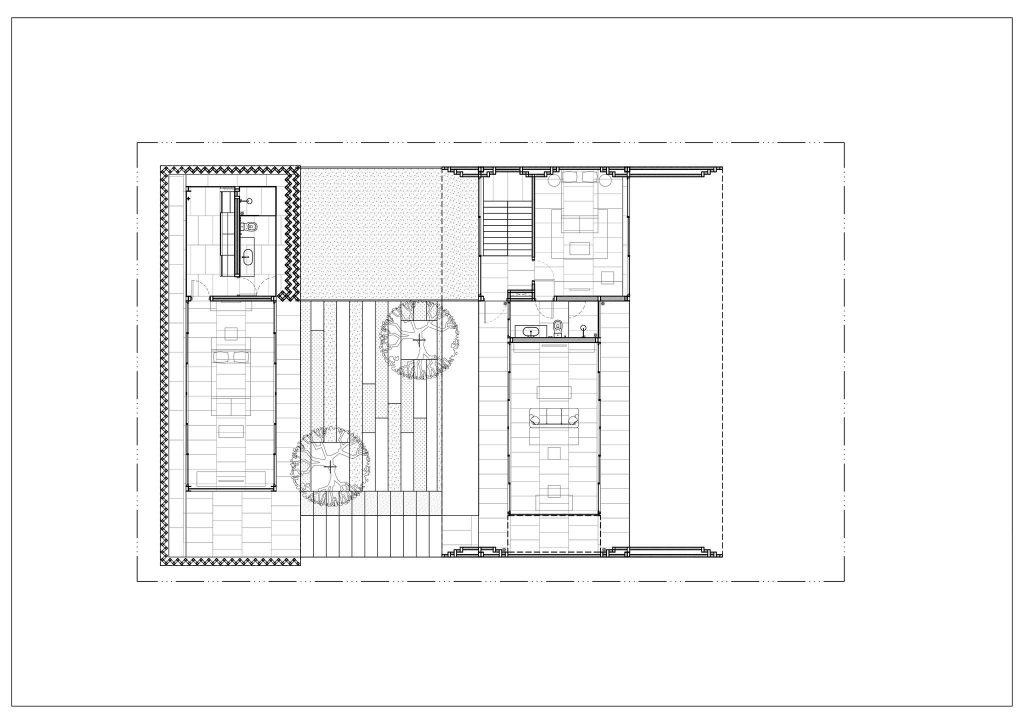
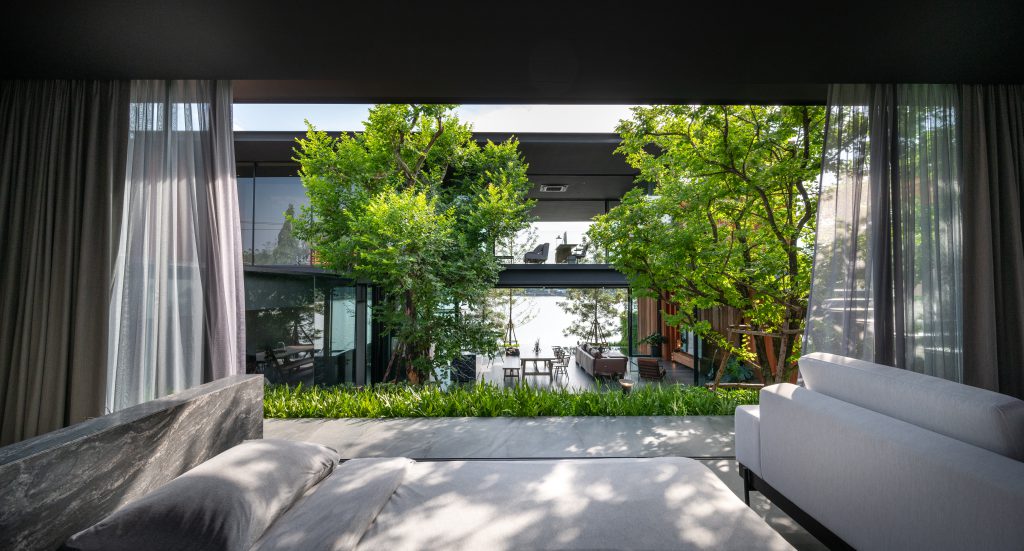
With the view of the lake being the focal point, the design reconciles the living spaces into different levels. From the lakeside garden, the living space is constructed 1.2 meters above the lake’s level to have full access to the view. The area connects to the central courtyard as the program continues to ascend to the bedroom, which rests on the hill elevated 1.8 meters from the ground. The walkway leads up to the sleeping quarter on the second floor whose mass protrudes as the roof structure for the parking space below. The house’s elevation facing toward the lake enables the sliding glass doors to fully open and take in the outside view without any obstruction.
The design manages the house’s privacy from the entrance and circulation by employing an element of surprise, which is an approach often used for resorts or museums. “We rarely design this type of circulation for a house because this is the place the owner uses everyday and it’s easy to get used to. But being able to reset your mind simply by walking into your house or the happiness you get from seeing people get excited by the house’s resort-like space can be quite a joy,” explained Thawin.
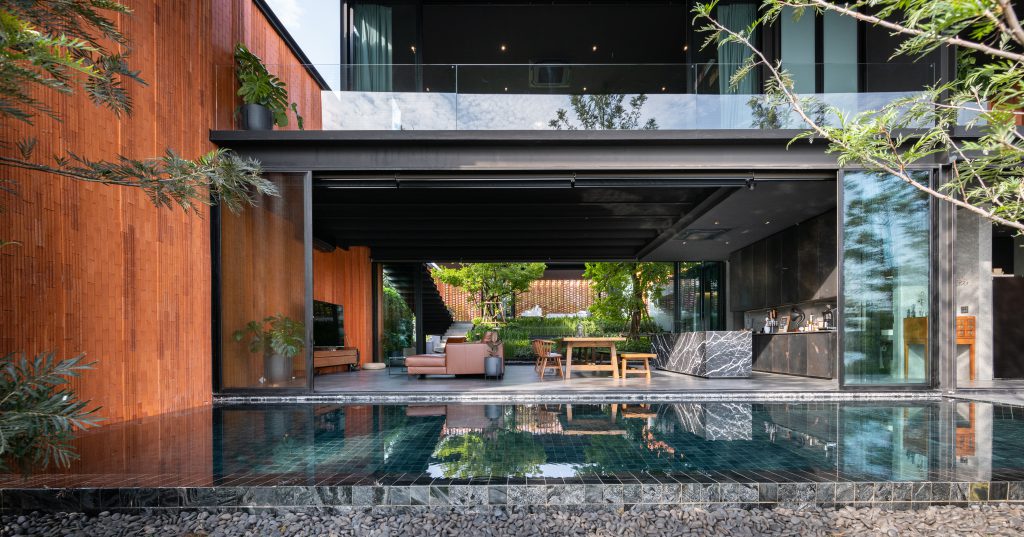
The front of the house facing the road is designed to have a brick façade built into an airy, zigzag pattern. The 5 x 5 x 30 bricks create a configuration with 4:6 ratios, offering both the visuals and needed privacy. The reason behind the use of bricks as the material for the façade is the fact that bricks contain physical attributes that remain beautiful even after an extended period of use. The central courtyard houses two large black currant trees that protect the bedroom from sunrays, heat and visual access from the outside. The trees’ curtain-like form, dark stems and light green leaves serve as a natural partition that brings privacy to the living space. A walkway connecting the living room building to the bedroom building has no roof, accentuating the presence of architectural structures and the aesthetic experiences obtained through the inhabitant’s direct and close exposure to the surrounding nature.

“Good architecture often contains an element of surrealism, but most people don’t really notice it.” Thawin proceeded to explain how this particular space is entirely different from most homes due to the owner’s understanding and willingness to accept the unexpected weather conditions as a part of the living experience. On a rainy day, an umbrella is needed since the floor that links the living space to the bedroom will get wet. The owner is well aware of this fact and embraces it.
The heart of the house is the living space, this is the area where the owner works on his music and relaxes throughout the day. The wide curtain wall fully opens to take in the presence of the courtyard and view of the lake. The lake-facing side happens to be on the west, which means there is direct exposure to the afternoon sun. The architect designs for the canopy to protrude 3.5 meters from the building to help protect the living area from the sun. The mirror of the curtain wall is laminated with sun protection film with a set of curtains installed on the days when the sun is particularly strong.

The interior design and materials have the owner’s previous home as the reference. Many of the details are realized from the design team’s conversations with the owner to choose materials that would best suit his personal taste. The discussion came down to the ‘clean loft’ style where unusual textural details of marble grain surface, bricks and rusty metal add a homey feel and sentiment to the house’s architecture and interiors.
We asked Thawin about the challenges of the project. “The conditions we had to work with were really great because the owner knows who he is and what he wants, in terms of lifestyle and personal preferences. He was very open to the ideas we had so we felt that there were so many possibilities we could do with this project. Limitations weren’t the challenge. The difficulty honestly lies in the unlimited possibilities because the greater the possibilities, the more challenging the work is.”

Superficially, the house seems very open with curtain walls that makes the entire living space look like it can be accessed visually. But with the help of design, masterful use of materials and architectural compositions, everything collectively contributes to the architecture that answers to both the owner’s private lifestyle and his desire to live closer to nature. While there’s a significant contrast between the definitions of privacy, openness and seeing through, a good work of design finds a way for the two elements to coexist beautifully, creating a home that brings its owner great joy and pride.




